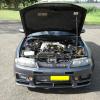H3C Globes Blowing
Announcements
-
Similar Content
-
Latest Posts
-
I am yet to see anyone ever regret a quaife or helical. ...other than drifting/skidpan duties. I kind of want to upgrade my factory helical with a Quaife (but really it's not ultimately that different, and is a MASSIVE UNDERTAKING), that's how good the hype is about them, that I want to try them 'just to see'
-
D2 and Ksport are essentially the same thing and basically just generic Taiwanese manufacture. Better than ChinaBay crap, but... not top shelf. Öhlins have got to be some of the best dampers around, so likely to be a good option. It's going to get to the point though where I suggest you buy from Oz. We have at least 2x excellent options here. If I were you though, I'd be talking to KW about doing something for the R33. There's bugger all difference between that and the 32. In GTR land, anyway.
-
KW only offers a set for the R32 GTR. Popular options are D2 racing, Ksport or Öhlins. I have a D2 Racing coilover set, though I don't know for sure which one.
-
Well, the good news is you have more than one very good option for new coilovers in and around your country. Worth the drive over to KW to talk about GTR stuff.
-
Fair enough, I am in no way a tire expert so I'm not familiar with all the terms and conditions. I'll definitely note down the AD09 to potentially try in the future. Rain is not too big of a concern for now as I will probably only drive in the rain when I have to. And considering I still lack experience driving the GTR I'd more than likely take it easy too. I have coilovers in the car but as I barely got to drive so far I never bothered to even check if they are adjustable haha. The suspension is almost entirely old and worn as well so I suppose when I eventually fix that in the future that would make a huge difference.
-






Recommended Posts
Create an account or sign in to comment
You need to be a member in order to leave a comment
Create an account
Sign up for a new account in our community. It's easy!
Register a new accountSign in
Already have an account? Sign in here.
Sign In Now